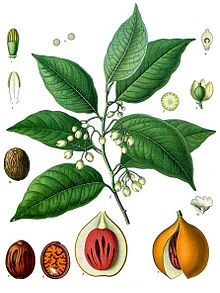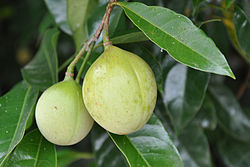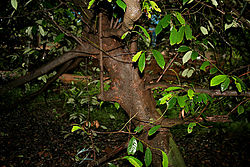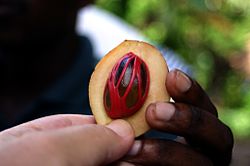
Nutmeg
About this schools Wikipedia selection
SOS believes education gives a better chance in life to children in the developing world too. SOS Children works in 45 African countries; can you help a child in Africa?
| Nutmeg | |
|---|---|
 |
|
| Myristica fragrans | |
| Scientific classification | |
| Kingdom: | Plantae |
| (unranked): | Angiosperms |
| (unranked): | Magnoliids |
| Order: | Magnoliales |
| Family: | Myristicaceae |
| Genus: | Myristica Gronov. |
| Species | |
|
See text |
|
The nutmeg tree is any of several species of trees in genus Myristica. The most important commercial species is Myristica fragrans, an evergreen tree indigenous to the Banda Islands in the Moluccas (or Spice Islands) of Indonesia. The nutmeg tree is important for two spices derived from the fruit: nutmeg and mace.
Nutmeg is the seed of the tree, roughly egg-shaped and about 20 to 30 mm (0.8 to 1.2 in) long and 15 to 18 mm (0.6 to 0.7 in) wide, and weighing between 5 and 10 g (0.2 and 0.4 oz) dried, while mace is the dried "lacy" reddish covering or aril of the seed. The first harvest of nutmeg trees takes place 7–9 years after planting, and the trees reach full production after 20 years. Nutmeg is usually used in powdered form. This is the only tropical fruit that is the source of two different spices. Several other commercial products are also produced from the trees, including essential oils, extracted oleoresins, and nutmeg butter (see below).
The common or fragrant nutmeg, Myristica fragrans, native to the Banda Islands of Indonesia, is also grown in Penang Island in Malaysia and the Caribbean, especially in Grenada. It also grows in Kerala, a state in southern India. Other species of nutmeg include Papuan nutmeg M. argentea from New Guinea, and M. malabarica from India.
Botany and cultivation
Nutmeg is a dioecious plant which is propagated sexually and asexually, the latter being the standard. Sexual propagation by seedling yields 50% male seedlings, which are unproductive. As there is no reliable method of determining plant sex before flowering in the sixth to eighth year, and sexual propagation bears inconsistent yields, grafting is the preferred method of propagation. Epicotyl grafting, approach grafting and patch budding have proved successful, epicotyl grafting being the most widely adopted standard. Air-layering, or marcotting, is an alternative, though not preferred, method, because of its low (35-40%) success rate.
| Selected Myristica species | ||||
|---|---|---|---|---|
| M. acsmithii M. agusanensis |
|
M. fusca |
|
M. ornata |

Culinary uses
Nutmeg and mace have similar sensory qualities, with nutmeg having a slightly sweeter and mace a more delicate flavour. Mace is often preferred in light dishes for the bright orange, saffron-like hue it imparts. Nutmeg is used for flavouring many dishes, usually in ground or grated form, and is best grated fresh in a nutmeg grater.
In Penang cuisine, dried, shredded nutmeg rind with sugar coating is used as toppings on the uniquely Penang ais kacang. Nutmeg rind is also blended (creating a fresh, green, tangy taste and white colour juice) or boiled (resulting in a much sweeter and brown juice) to make iced nutmeg juice.
In Indian cuisine, nutmeg is used in many sweet as well as savoury dishes (predominantly in Mughlai cuisine). It is also added in small quantities as a medicine for infants. It may also be used in small quantities in garam masala. Ground nutmeg is also smoked in India.
In Indonesian cuisine, nutmeg is used in various dishes, mainly in many soups, such as soto soup, baso soup or Sup Kambing. It is also made as sweets.
In Middle Eastern cuisine, ground nutmeg is often used as a spice for savoury dishes.
In originally European cuisine, nutmeg and mace are used especially in potato dishes and in processed meat products; they are also used in soups, sauces, and baked goods. In Dutch cuisine, nutmeg is added to vegetables such as Brussels sprouts, cauliflower, and string beans. Nutmeg is a traditional ingredient in mulled cider, mulled wine, and eggnog.
Japanese varieties of curry powder include nutmeg as an ingredient.
In the Caribbean, nutmeg is often used in drinks such as the Bushwacker, Painkiller, and Barbados rum punch. Typically, it is just a sprinkle on the top of the drink.
The pericarp (fruit/pod) is used in Grenada and also in Indonesia to make jam, or is finely sliced, cooked with sugar, and crystallised to make a fragrant candy.
In Scotland, mace and nutmeg are usually both essential ingredients in haggis.
Essential oils
The essential oil obtained by steam distillation of ground nutmeg is used widely in the perfumery and pharmaceutical industries. This volatile fraction typically contains 60-80% d- camphene by weight, as well as quantities of d- pinene, limonene, d- borneol, l- terpineol, geraniol, safrol, and myristicin. The oil is colourless or light yellow, and smells and tastes of nutmeg. It contains numerous components of interest to the oleochemical industry, and is used as a natural food flavouring in baked goods, syrups, beverages, and sweets. It is used to replace ground nutmeg, as it leaves no particles in the food. The essential oil is also used in the cosmetic and pharmaceutical industries, for instance, in toothpaste, and as a major ingredient in some cough syrups. In traditional medicine, nutmeg and nutmeg oil were used for disorders related to the nervous and digestive systems.
After extraction of the essential oil, the remaining seed, containing much less flavour, is called "spent". Spent is often mixed in industrial mills with pure nutmeg to facilitate the milling process, as nutmeg is not easy to mill due to the high percentage of oil in the pure seed. Ground nutmeg with a variable percentage of spent (around 10% w/w) is also less likely to clot. To obtain a better running powder also a small percentage of rice flour can be added.
Nutmeg butter
Nutmeg butter is obtained from the nut by expression. It is semi-solid, reddish brown in colour, and tastes and smells of nutmeg. Approximately 75% (by weight) of nutmeg butter is trimyristin, which can be turned into myristic acid, a 14-carbon fatty acid, which can be used as a replacement for cocoa butter, can be mixed with other fats like cottonseed oil or palm oil, and has applications as an industrial lubricant.
History
It is known to have been a prized costly spice in European medieval cuisine as a flavouring, medicinal, and preservative agent. Saint Theodore the Studite (ca. 758 – ca. 826) allowed his monks to sprinkle nutmeg on their pease pudding when required to eat it. In Elizabethan times, it was believed nutmeg could ward off the plague, so nutmeg became very popular and its price skyrocketed.
The small Banda Islands were, until the mid-19th century, the world's only source of nutmeg and mace. Nutmeg is noted as a very valuable commodity by Muslim sailors from the port of Basra, such as Sinbad the Sailor in the One Thousand and One Nights. Nutmeg was traded by Arabs during the Middle Ages and sold to the Venetians for very high prices, but the traders did not divulge the exact location of their source in the profitable Indian Ocean trade, and no European was able to deduce their location.
In August 1511, Afonso de Albuquerque conquered Malacca, which at the time was the hub of Asian trade, on behalf of the king of Portugal. In November of that year, after having secured Malacca and learning of the Bandas' location, Albuquerque sent an expedition of three ships led by his friend António de Abreu to find them. Malay pilots, either recruited or forcibly conscripted, guided them via Java, the Lesser Sundas and Ambon to Banda, arriving in early 1512. The first Europeans to reach the Bandas, the expedition remained in Banda for about a month, purchasing and filling their ships with Banda's nutmeg and mace, and with cloves in which Banda had a thriving entrepôt trade. The first written accounts of Banda are in Suma Oriental, a book written by the Portuguese apothecary Tomé Pires, based in Malacca from 1512 to 1515. Full control of this trade by the Portuguese was not possible, and they remained participants without a foothold in the islands themselves.
The trade in nutmeg later became dominated by the Dutch in the 17th century. The English and Dutch engaged in prolonged struggles to gain control of Run Island, then the only source of nutmeg. At the end of the Second Anglo-Dutch War, the Dutch gained control of Run, while England controlled New Amsterdam (New York) in North America.
The Dutch waged a bloody war, including the massacre and enslavement of the inhabitants of the island of Banda, just to control nutmeg production in the East Indies in 1621. Thereafter, the Banda Islands were run as a series of plantation estates, with the Dutch mounting annual expeditions in local war-vessels to extirpate nutmeg trees planted elsewhere.
In 1760, the price of nutmeg in London was 85 to 90 shillings per pound, a price kept artificially high by the Dutch voluntarily burning full warehouses of nutmegs in Amsterdam.
As a result of the Dutch interregnum during the Napoleonic Wars, the British took temporary control of the Banda Islands from the Dutch and transplanted nutmeg trees (complete with soil) to Sri Lanka, to Penang, to Bencoolen and to Singapore. However, there is evidence that the tree existed in Sri Lanka prior to this. Thence they were transplanted to their other colonial holdings elsewhere, notably Zanzibar and Grenada. The national flag of Grenada, adopted in 1974, shows a stylised split-open nutmeg fruit. The Dutch however continued to hold control of the spice islands until World War II
Connecticut gets its nickname ("the Nutmeg State", " Nutmegger") from the legend that some unscrupulous Connecticut traders would whittle "nutmeg" out of wood, creating a "wooden nutmeg" (a term which came to mean any fraud).
World production
World production of nutmeg is estimated to average between 10,000 and 12,000 tonnes (9,800 and 12,000 long tons; 11,000 and 13,000 short tons) per year, with annual world demand estimated at 9,000 tonnes (8,900 long tons; 9,900 short tons); production of mace is estimated at 1,500 to 2,000 tonnes (1,500 to 2,000 long tons; 1,700 to 2,200 short tons). Indonesia and Grenada dominate production and exports of both products, with world market shares of 75% and 20% respectively. Other producers include India, Malaysia (especially Penang, where the trees grow wild within untamed areas), Papua New Guinea, Sri Lanka, and Caribbean islands, such as St. Vincent and Grenada, which produces 20% of the world's nutmeg supply. The principal import markets are the European Community, the United States, Japan and India. Singapore and the Netherlands are major re-exporters.
Medical research
Nutmeg has been used in medicine since at least the seventh century. In the 19th century it was used as an abortifacient, which led to numerous recorded cases of nutmeg poisoning. Although used as a folk treatment for other ailments, unprocessed nutmeg has no proven medicinal value today.
One study has shown that the compound macelignan isolated from Myristica fragrans (Myristicaceae) may exert antimicrobial activity against Streptococcus mutans, and another that a methanolic extract from the same plant inhibited Jurkat cell activity in human leukemia, but these are not currently used treatments.
Psychoactivity and toxicity
Effects
In low doses, nutmeg produces no noticeable physiological or neurological response, but in large doses, raw nutmeg has psychoactive effects. In its freshly ground (from whole nutmegs) form, nutmeg contains myristicin, a monoamine oxidase inhibitor and psychoactive substance. Myristicin poisoning can induce convulsions, palpitations, nausea, eventual dehydration, and generalized body pain. It is also reputed to be a strong deliriant.
Fatal myristicin poisonings in humans are very rare, but two have been reported: one in an 8-year-old child and another in a 55-year-old adult, the latter case attributed to a combination with flunitrazepam.
In case reports raw nutmeg produced anticholinergic-like symptoms, attributed to myristicin and elemicin.
In case reports intoxications with nutmeg had effects that varied from person to person, but were often reported to be an excited and confused state with headaches, nausea and dizziness, dry mouth, bloodshot eyes and memory disturbances. Nutmeg was also reported to induce hallucinogenic effects, such as visual distortions and paranoid ideation. In the reports nutmeg intoxication took several hours before maximum effect was reached. Effects and after-effects lasted up to several days.
Myristicin poisoning is potentially deadly to some pets and livestock, and may be caused by culinary quantities of nutmeg harmless to humans. For this reason, it is recommended not to feed eggnog to dogs.
History of use
Peter Stafford's Psychedelics Encyclopedia quotes an 1883 report from Mumbai noting that "the Hindus of West India take nutmeg as an intoxicant", and records that the spice has been used for centuries as a form of snuff in rural eastern Indonesia and India, latter seeing the ground seed mixed with betel and other kinds of snuff. In 1829, the Czech physiologist Jan Evangelista Purkinje ingested three ground nutmegs with a glass of wine and recorded headaches, nausea, hallucinations and a sense of euphoria that lasted for several days.
Harvard ethnobotanist Richard Evans Schultes and chemist Albert Hofmann, who discovered LSD, documented reports of nutmeg's use as an intoxicant by students, prisoners, sailors, alcoholics and marijuana smokers. In his autobiography, Malcolm X writes about taking nutmeg and other "semi-drugs" while serving time in prison.
The Angewandte Chemie International Edition records the use of nutmeg as an intoxicant in the United States in the post-World War II period, notably among young people, bohemians, and prisoners. A 1966 New York Times piece named it along with morning glory seeds, diet aids, cleaning fluids, cough medicine, and other substances as " alternative highs" on college campuses.
Toxicity during pregnancy
Nutmeg was once considered an abortifacient, but may be safe for culinary use during pregnancy. However, it inhibits prostaglandin production and contains hallucinogens that may affect the fetus if consumed in large quantities.




